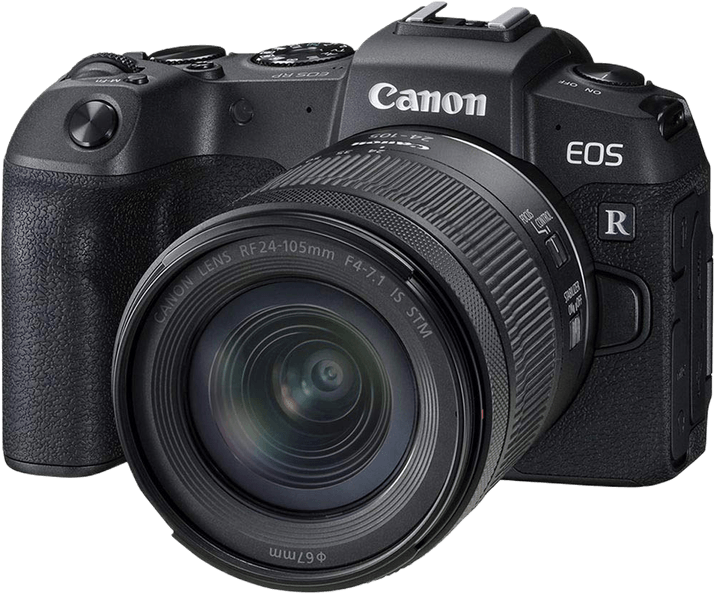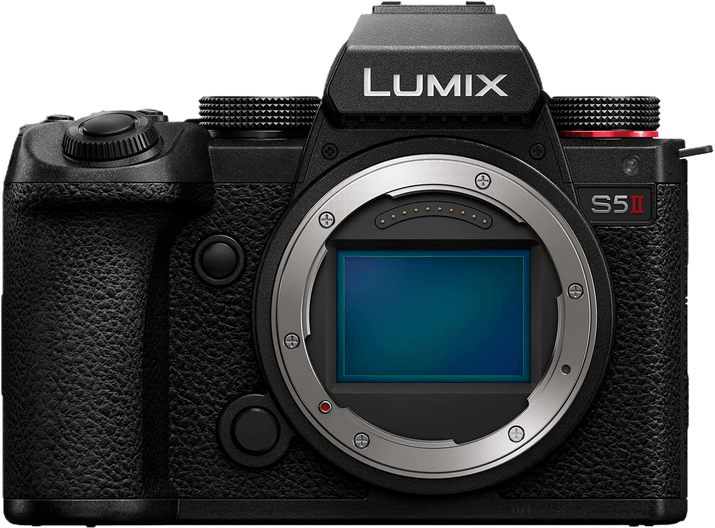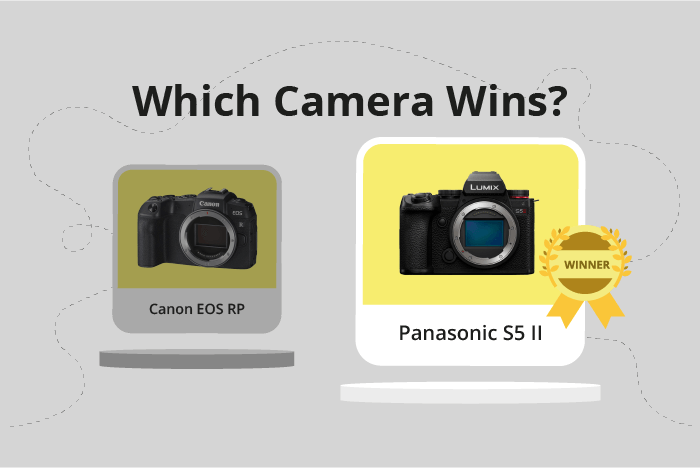Canon EOS RP vs Panasonic Lumix S5 II Comparison
Canon EOS RP

Panasonic Lumix DC-S5 II

The Panasonic Lumix S5 II outperforms the Canon EOS RP with a score of 76/100 compared to 65/100. Both cameras share similarities as mirrorless cameras released in 2019 and 2023, respectively. They have comparable sizes, with the Lumix S5 II slightly larger at 134 x 102 x 90mm and heavier at 740g, while the EOS RP measures 133 x 85 x 70mm and weighs 440g.
The Lumix S5 II excels with its higher score, reflecting its superior performance and features. However, the Canon EOS RP stands out with its lower launch price of $1300, making it a more affordable option compared to the Lumix S5 II’s $1999.99 price tag.
Taking into account each camera’s specifications and performance, the Panasonic Lumix S5 II proves to be a better camera, while the Canon EOS RP offers a more budget-friendly alternative for those seeking a mirrorless camera.
Canon EOS RP vs Panasonic Lumix S5 II Overview and Optics
The Panasonic Lumix S5 II outperforms the Canon EOS RP in optics with a score of 73/100, while the Canon EOS RP scores 67/100. Both cameras share common specifications such as CMOS sensor type, full-frame sensor size, and similar megapixel counts (26 for Canon EOS RP and 24 for Panasonic Lumix S5 II).
The Lumix S5 II has a clear advantage in shooting speed, boasting 9 frames per second compared to the EOS RP’s 5 frames per second. This difference allows the Lumix S5 II to capture fast-moving subjects more efficiently. Additionally, the Lumix S5 II features image stabilization, which the EOS RP lacks. This technology helps reduce camera shake and results in sharper images, particularly in low-light conditions or when using telephoto lenses.
On the other hand, the Canon EOS RP has a higher DXOMARK score for its sensor at 85, compared to the Lumix S5 II’s 72. This difference means the EOS RP has better image quality in terms of color, dynamic range, and low-light performance. However, the Lumix S5 II compensates for this with its image stabilization feature, which can help improve image quality in certain situations.
The Canon EOS RP uses the Canon RF lens mount, while the Panasonic Lumix S5 II uses the Leica L lens mount. This difference in lens mounts is crucial to consider when choosing a camera system, as it affects the range and compatibility of lenses available.
To sum up, the Panasonic Lumix S5 II excels in shooting speed and image stabilization, making it a better choice for action photography and low-light situations. The Canon EOS RP, on the other hand, offers superior sensor performance, which may be more appealing to those who prioritize image quality over speed and stabilization. Ultimately, the choice between these two cameras depends on the specific needs and preferences of the user.
Canon EOS RP vs Panasonic Lumix S5 II Video Performance
The Panasonic Lumix S5 II outperforms the Canon EOS RP in video capabilities, scoring 96 out of 100, compared to the Canon EOS RP’s score of 70. Both cameras share some similarities in video features, such as having a built-in time-lapse functionality. However, the Panasonic Lumix S5 II has several advantages over the Canon EOS RP.
The Lumix S5 II offers a higher maximum video resolution of 6K and dimensions of 5952 x 3968, while the EOS RP’s maximum video resolution is 4K with dimensions of 3840 x 2160. This difference in resolution allows the Lumix S5 II to capture more detail and produce higher quality videos. Additionally, the Lumix S5 II has a significantly higher maximum video frame rate of 120fps, compared to the EOS RP’s 25fps. This higher frame rate enables the Lumix S5 II to capture smoother slow-motion footage and more dynamic action scenes.
Although the Canon EOS RP falls short in some areas, it still offers reliable video performance with its 4K resolution and built-in time-lapse functionality. For users who prioritize video capabilities, the Panasonic Lumix S5 II proves to be the superior choice due to its higher resolution and frame rate.
Considering the specs and performance of both cameras, the Panasonic Lumix S5 II is the clear winner in terms of video capabilities. The Canon EOS RP, while still offering decent video performance, cannot match the Lumix S5 II’s higher resolution and frame rate. Users who prioritize video performance should opt for the Panasonic Lumix S5 II to take advantage of its superior video features.
Canon EOS RP vs Panasonic Lumix S5 II Features and Benefits
The Panasonic Lumix S5 II outperforms the Canon EOS RP in terms of features, with a score of 85/100 compared to the EOS RP’s 70/100. Both cameras share a 3-inch screen size, lack of GPS, and have touchscreens, flip screens, WIFI, and Bluetooth capabilities. However, there are noticeable differences in their performance.
The Lumix S5 II excels with a higher screen resolution of 2,360,000 dots, nearly 2.3 times more than the EOS RP’s 1,040,000 dots. This significant difference allows the Lumix S5 II to provide a sharper and more detailed display for a better user experience.
On the other hand, the Canon EOS RP does not surpass the Lumix S5 II in any specific feature. Both cameras have the same screen size, and the EOS RP’s lower screen resolution does not offer any advantage. The shared specifications between the two cameras do not provide any edge for the EOS RP.
To conclude, the Panasonic Lumix S5 II is the superior camera in terms of features due to its higher screen resolution. The Canon EOS RP, while sharing some specifications with the Lumix S5 II, does not offer any unique advantages. The Lumix S5 II’s higher feature score reflects its overall better performance and user experience.
Canon EOS RP vs Panasonic Lumix S5 II Storage and Battery
The Panasonic Lumix S5 II outperforms the Canon EOS RP in storage and battery with a score of 68/100, compared to the Canon’s 29/100. Both cameras accept SD, SDHC, and SDXC memory cards and have USB charging capabilities. However, the Lumix S5 II has two memory card slots, while the EOS RP only has one. Additionally, the Lumix S5 II offers longer battery life with 370 shots, compared to the EOS RP’s 250 shots.
The Canon EOS RP’s advantage is its compatibility with UHS-II memory cards, allowing for faster read and write speeds. Despite this, the Lumix S5 II’s dual memory card slots and longer battery life make it the superior choice for storage and battery performance.
Canon EOS RP vs Panasonic Lumix S5 II – Our Verdict
Are you still undecided about which camera is right for you? Have a look at these popular comparisons that feature the Canon EOS RP or the Panasonic Lumix S5 II:

